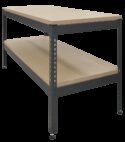Experiment
TD1360D
JACKETED VESSEL AND COIL
Small scale educational jacketed vessel and coil heat exchanger.
If you have any questions or you'd like to discuss a product, please call us.
+44 1159 722 611JACKETED VESSEL AND COIL
This heat exchanger mimics those used in the process industry. It can show heat transfer by using the outer skin (or ‘jacket’) of the vessel, or by a coil inside the vessel. You can set a continuous feed to the vessel for heating or you set a fixed batch for heating. The unit has an extra thermocouple to measure the batch temperature. It also has a motorised stirrer to show how stirring affects heat transfer.
The Service Module (TD360) provides hot and cold water to the heat exchanger and all the instruments needed to measure its performance. All fluid connections between the Service Module and the heat exchanger are self-sealing quick connectors – for safety and simplicity. The hot and cold fluid streams have different connectors to reduce errors.
The bedplate fixes to the Service Module with thumbscrews.
Learning outcomes
- Demonstration of heat transfer from one fluid to another through a solid wall.
- Introduction to the logarithmic mean temperature difference in heat exchangers.
- Comparison of different types of heat exchanger in terms of performance, size and relative cost (only if you have two or more optional heat exchangers).
- Flow-through and batch heating, with or without stirring, using a heating jacket or a coil.



